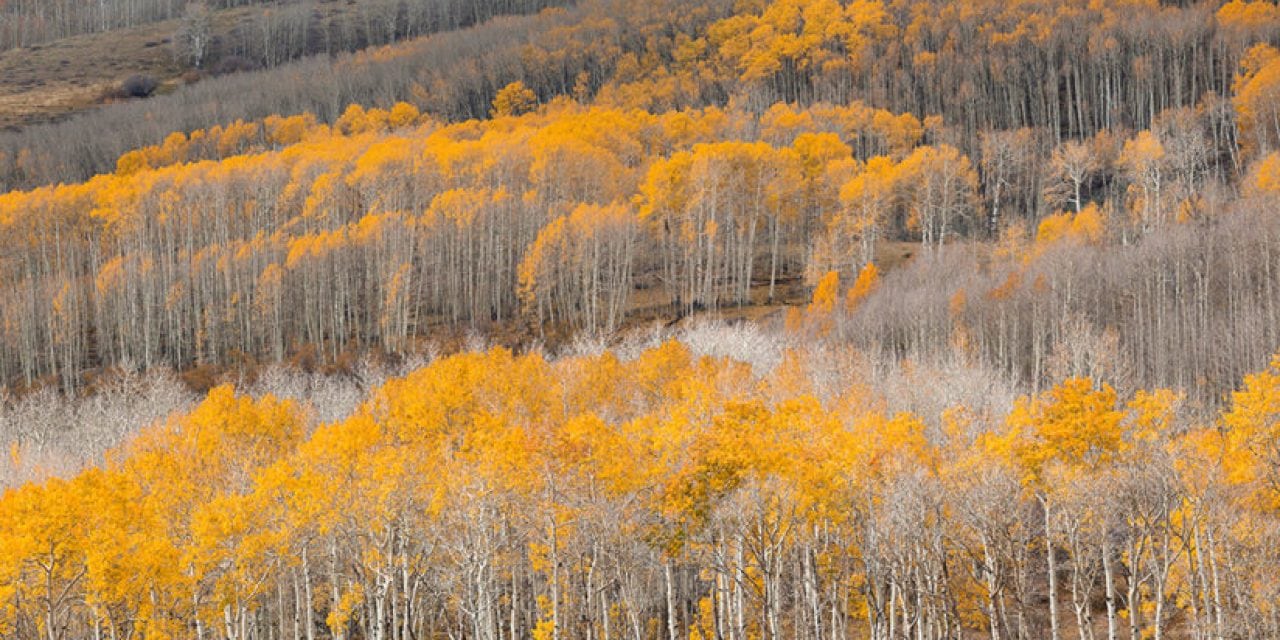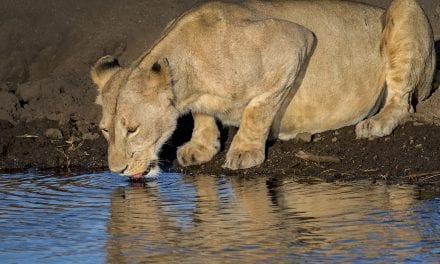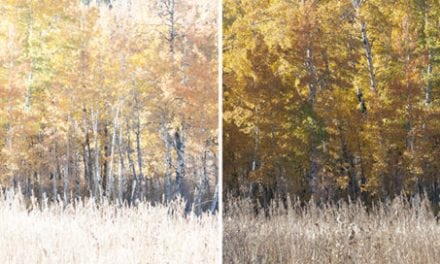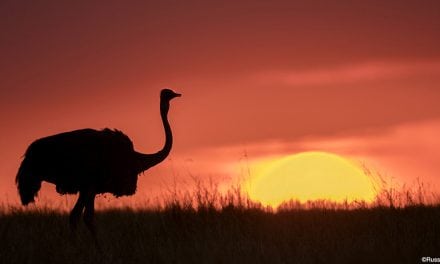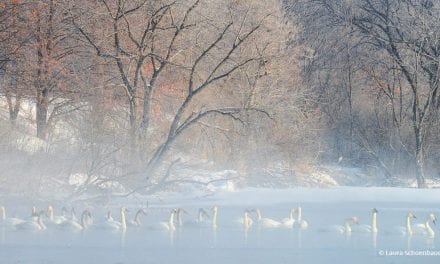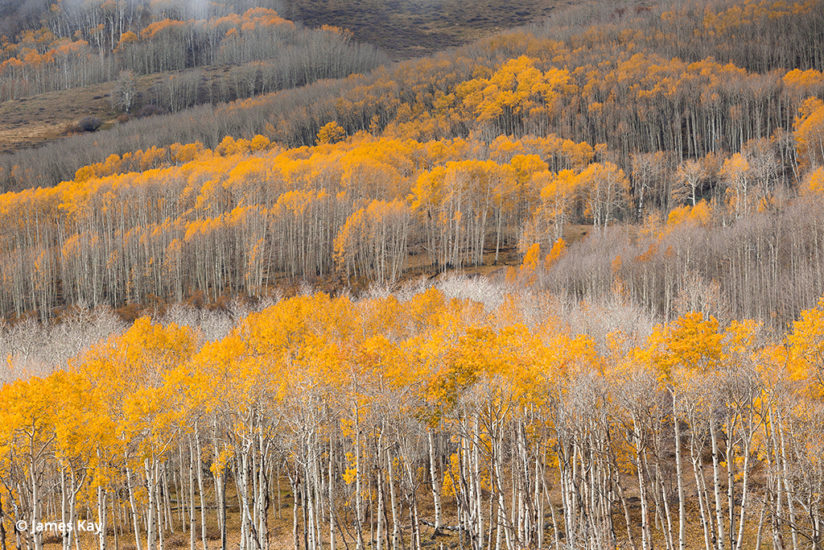
While most of us think of the northern woods of Vermont and New Hampshire, the southern forests of the Great Smoky Mountains, or perhaps the aspen-covered heights of the Colorado Rockies as the best locations for autumn-color photography, few of us set our sights on the red rock canyons and high plateaus of southern Utah—which is curious, because this region contains some of the most spectacular displays of fall color in America.
I still recall the kaleidoscopic hues of autumn that carpeted the rolling hills around my childhood home in northern New Jersey. As one of the most ecologically diverse forests on earth, the woodlands of the Appalachian Mountains contain a wide variety of deciduous tree species, with nearly every hue on the warm side of the color wheel represented as the green chlorophyll drains from their leaves every autumn. Compared to this full-spectrum display, the predominant autumn colors of southern Utah are the brilliant yellows and oranges of aspen trees high in the mountains or the rich golden-yellows of cottonwood trees deep in the red rock canyons.
While there’s much to be said for the tremendous variety of autumn hues back east, there’s also something clean, pure and refreshingly uncluttered about an entire mountainside covered with a monoculture of aspen trees with shimmering yellow leaves and crisp white trunks beneath a deep-blue western sky filled with Salvador Dali clouds.
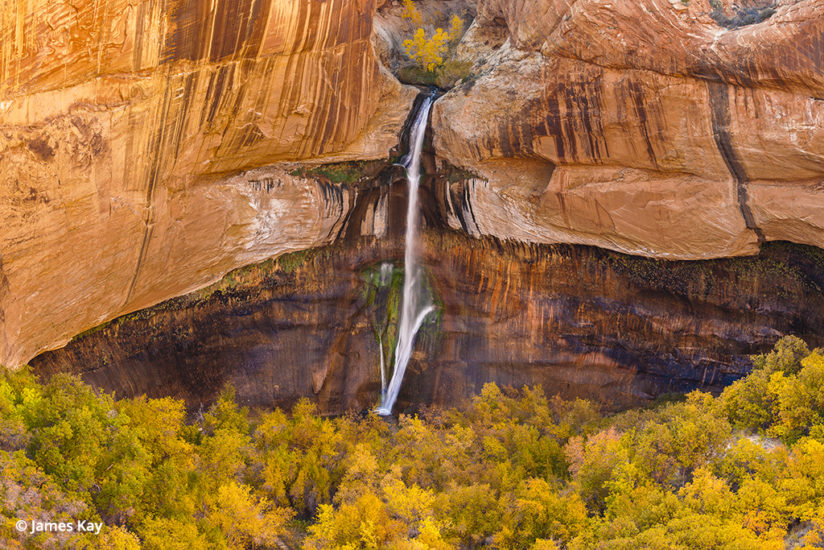
One of the things I’ve always found most compelling about photography in Utah’s Canyonlands region is the vivid contrast between lush, green trees along canyon bottoms and the red and orange sandstone walls rising above them. But in the fall, when those same green leaves morph into their vibrant yellow hues, there are few regions anywhere on the planet as photographically unique as this landscape at this time of year.
Autumn color in southern Utah occurs in two vastly different ecological zones, the first being aspen trees between the elevations of 8,000 and 10,000 feet on the flanks of high-altitude plateaus with their leaves reaching their color peak around the first week of October. The second zone for autumn color is found deep in the red rock canyons, where perennial streams provide life support for thick groves of trees at elevations between 4,000 and 5,000 feet. The predominant color here is the golden-yellow of cottonwood and box elder trees with lesser numbers of red maple, yellow river birch and rusty-orange scrub oak. Due to the lower elevations of these canyons, these trees usually reach their peak of color in the last half of October into early November.
Compared to the drier Mojave desert to the southwest, the deserts of southern Utah are a relatively wet place, with countless small streams originating on the 11,000-foot rims of heavily forested volcanic plateaus. The vast majority of beautiful canyon systems in southern Utah—including the canyons of the Escalante River, Capitol Reef National Park and Zion National Park—were carved by streams originating on these plateaus. These same streams today continue to provide easy living conditions along canyon bottoms for a variety of water-loving trees and plants in the otherwise harsh, dry desert environment.
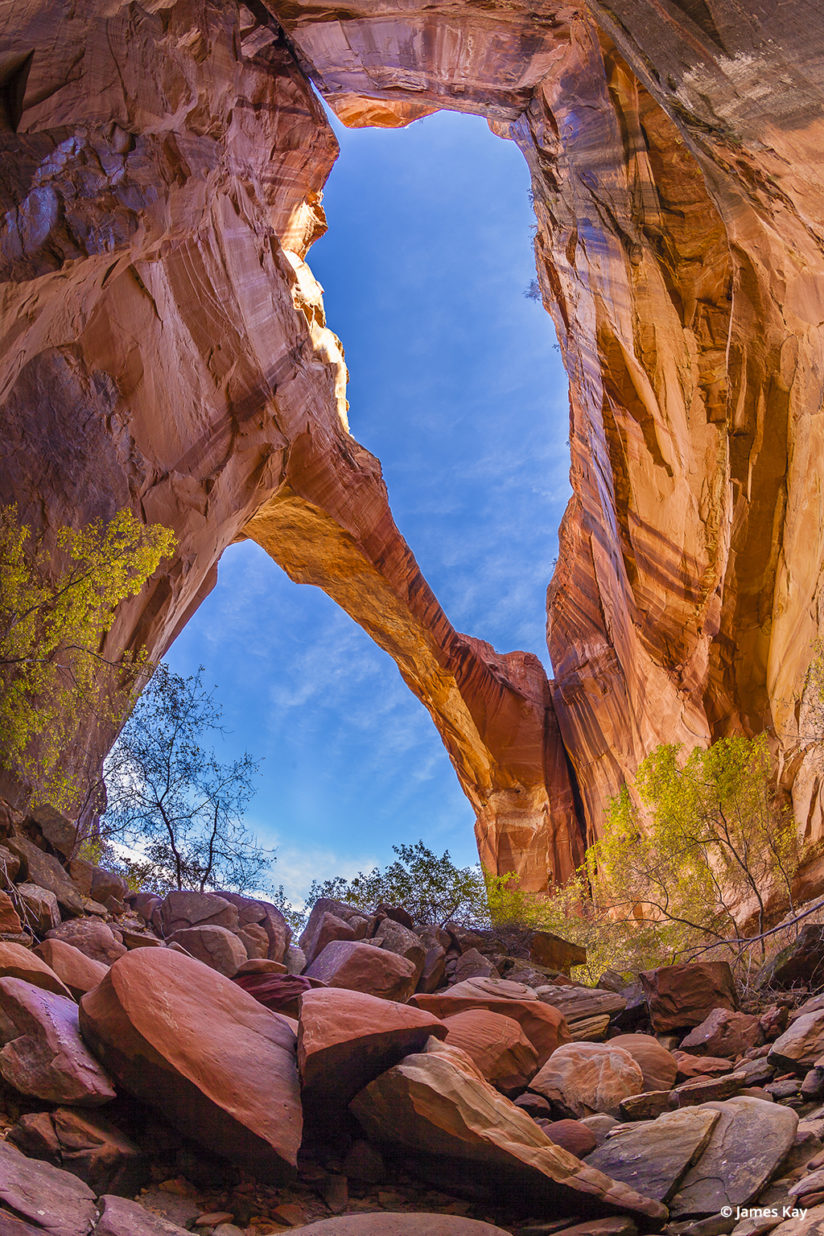
Regardless of the season, the Escalante River Canyons have always been my favorite location for photography in southern Utah. It’s easy to get lost in the folds of its deep, sinuous canyons with mile after mile of tributaries carved into thick layers of sandstone, many of them sheltering cool, small streams lined with lush vegetation. One of my first autumn-color photo excursions in southern Utah was a five-day backpacking trip down the upper Escalante from its confluence with Calf Creek to Harris Wash. Thick groves of cottonwood trees along this 30-mile stretch of canyon begin to turn yellow as the cold nights of late October set in. With all the stream crossings, I still remember how my waterlogged boots were frozen solid every morning and how difficult it was to get back into them. If you study topographical maps of this region, you’ll notice a number of tributary canyons along this section of river, all of them lined with vibrant groves of cottonwood and box elder trees. If you’re not quite up for an adventure like this—preferring not to scrape ice off your boots every morning—I do offer an autumn workshop in this area based in the very comfortable and well-heated Boulder Mountain Lodge.
If late October in the canyons doesn’t work for your schedule, you could always arrive a few weeks earlier to catch the aspen colors higher up on the plateaus. Boulder Mountain, also known as the Aquarius Plateau—the largest high-altitude plateau in North America—was formed as a shield volcano over 20 million years ago. Today, it’s the source of the Escalante River and one of the best aspen-color displays in the West. The ideal elevation for aspen at this latitude is between 8,000 and 10,000 feet, and Boulder Mountain has an ample supply of real estate at precisely this altitude. You’ll find thousands of acres of aspen trees with their shimmering leaves and tremendous views overlooking the canyons of both the Escalante River and Capitol Reef National Park. The colors begin to change up here in late September and are usually gone by mid-October. The road connecting the towns of Boulder and Torrey provides easy access to many of these groves.
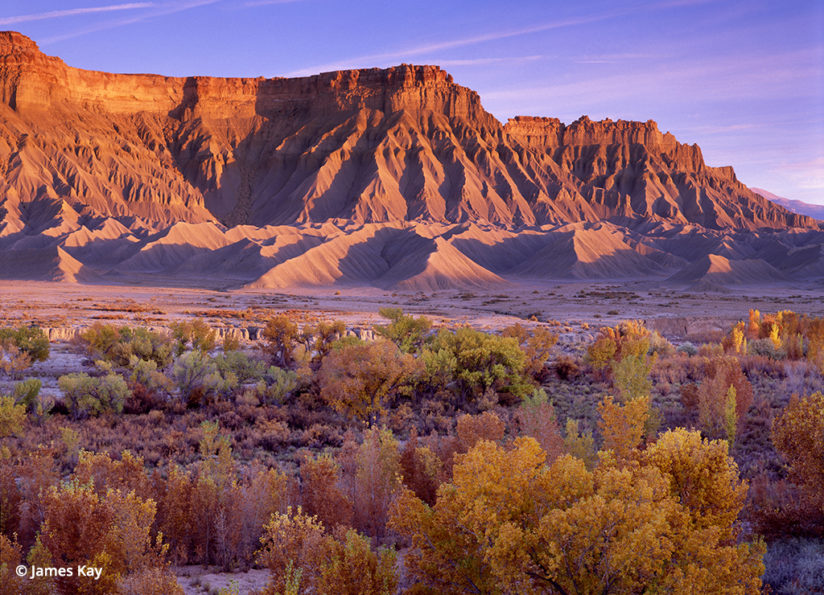
In addition to the Aquarius Plateau, the Markagunt Plateau north of Zion National Park and Fish Lake Plateau northwest of Capitol Reef also have vast expanses of aspen-covered slopes. On the Markagunt, the most prolific groves on Cedar Mountain can be accessed along the graded-gravel road between Kolob Reservoir and Cedar City. Further to the northeast, Fish Lake Plateau is the site of Utah’s largest glacier-carved lake and the largest aspen clone yet discovered in the world. In dry climates, aspen don’t reseed very well and instead propagate through vast underground root networks. These root systems can be thousands of years old, with trees continually sprouting from them. The entire root network and the trees are considered one living organism. This large clone was given the name of Pando (Latin for “I spread”), with its root system estimated to be at least 8,000 years old. It covers an area of more than 100 acres and weighs more than 6,000 tons. Sorry, blue whales and General Sherman tree—Pando is considered the largest and perhaps the oldest living organism on earth. (And I thought that title belonged to that seething mass of green mold growing in the bottom corner of my refrigerator’s vegetable drawer.) Anyway, these individual aspen clones explain why we see large clusters of aspen trees of one specific hue, say deep red-orange, with another solid cluster tinted bright yellow right beside it, with another cluster next door that has already shed all its leaves.
Continuing with our theme of cottonwood-lined streams originating on high plateaus, the Fremont River in Capitol Reef National Park is another of southern Utah’s hot spots for autumn colors. With its headwaters near the Pando Clone on Fish Lake Mountain, the Fremont River provides life-sustaining water for a 30-mile-long ribbon of cottonwood trees beginning at the pioneer village of Fruita, in the heart of Capitol Reef, and extending all the way to the town of Hanksville beneath the convoluted slopes of the Caineville Mesas. Along the way, the tributary streams of Pleasant Creek and Sandy Creek nurture their own cottonwood groves. Highway 24 through Capitol Reef parallels the Fremont River and its cottonwoods all the way to Hanksville.
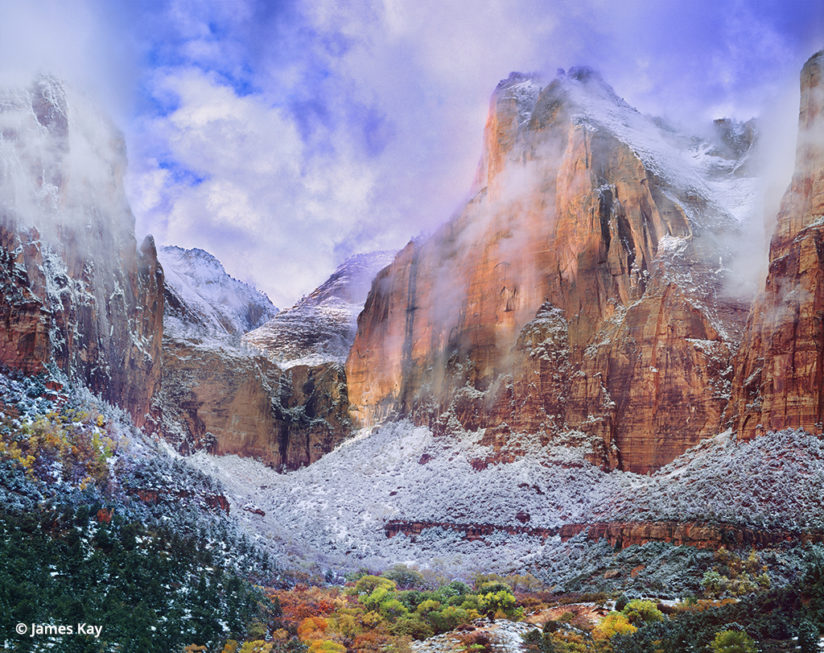
It’s not possible to consider autumn-color photography in southern Utah without including the spectacular canyons of Zion National Park. Located at the deeply eroded southern edge of the Markagunt Plateau, the trees of Zion owe their lives to the thick winter snowpack that accumulates on top of this vast plateau every winter, with its melt water feeding small streams and springs throughout the canyons. With its Yosemite-like cliffs rising thousands of feet above the cottonwood-lined Virgin River, Zion is a very popular destination, so you’ll need to plan far in advance if you want a room or a campsite. Due to its southerly location and lower elevation of 4,000 feet, the trees in the main canyon usually reach their color peak in the first two weeks of November, a couple weeks after those in the Escalante Canyons.
If you’re staying outside the park in Springdale, you’ll need to ride the shuttle bus to access locations along Zion Canyon, but if you’re staying in Zion Lodge, you could walk directly from your room. Try a loop hike from the lodge to Emerald Pools and from there to the Grotto shuttle stop and then back to the lodge. This is one of the best areas in the canyon to capture the colors.
One of the other main spots you’ll want to explore is the Gateway-to-the-Narrows trail, which starts at the end of the main road at the Temple of Sinewava. Jump off the shuttle bus here and spend the morning photographing the trees along this flat, mile-long trail paralleling the Virgin River, with 1,000-foot cliffs on both sides. This deep, cool canyon supports a rich diversity of plant life, most of which morphs into a tapestry of color during the first week of November.
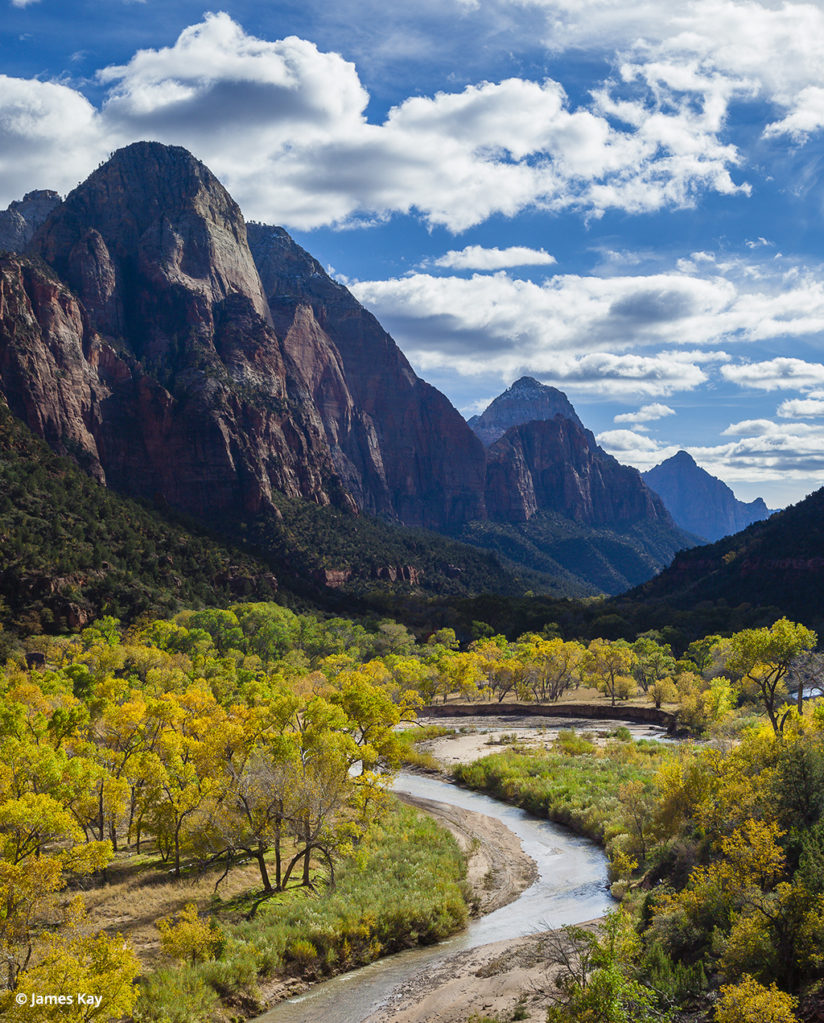
The other main location for colors in Zion would be along the Left Fork of North Creek on the west side of the park, otherwise known as Great West Canyon/The Subway. The small stream here is surrounded by soaring walls of sandstone and lush vegetation, with river birch and cottonwood trees providing most of the color. As this has become one of Zion’s most popular routes, you’ll need to arrange for your permit well in advance before setting off. It’s a steep 600-foot descent into the canyon but relatively easy walking once you arrive on the canyon floor. If you’d prefer a less-crowded, easier-to-access canyon, try Pine Creek above the Zion-Mount Carmel tunnel. While not nearly as spectacular as The Subway, you’ll find good water reflections, autumn colors and pleasant narrows, and you’ll have them all to yourself.
As you assemble your gear, don’t forget your polarizing filter. It’s probably the single most important tool for photographing foliage as it will vastly reduce reflections on the surfaces of leaves, thus accentuating their brilliant colors. This is effective both in direct sunlight and in open shade or flat light from overcast skies. Backlighting is also a good technique to employ if you want to enhance the brightness and color of the leaves.
If you’ve been paying attention over the years, you already know that the timing of the color peak is never exactly the same from year to year and depends on the climatic conditions of the previous summer. Variations in the temperate and amount of precipitation can cause brilliant displays one year and dismal displays the next. If you live close to the region and are able to depart on short notice to catch the exact color peak, check online for color updates or call someone in the region—at the park headquarters or your lodge—to see how things are progressing before you depart. Or, of course, if you have one of those annoying things called a job, you could always quit, pack up the car, and spend more than a month photographing the entire region, starting high on the volcanic slopes of Boulder and Fish Lake Mountains and ending up in Zion Canyon five weeks later.
The post Autumn On Utah’s Colorado Plateau appeared first on Outdoor Photographer.

